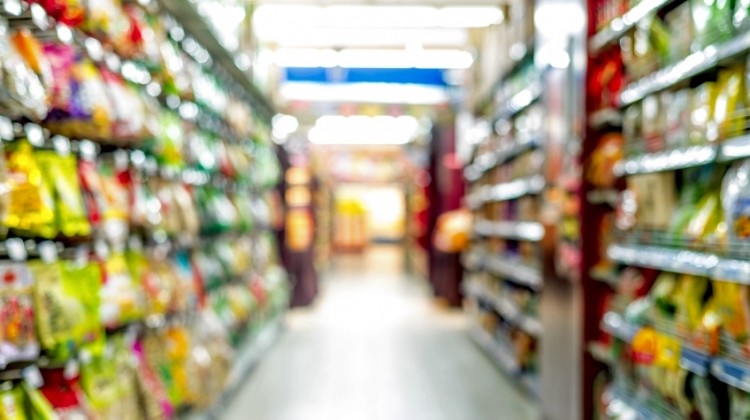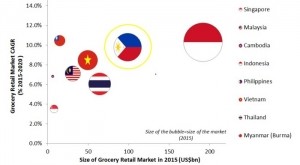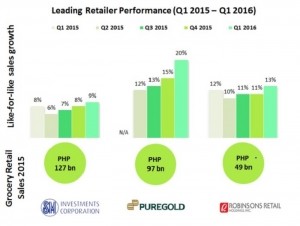Dateline Southeast Asia
Philippines grocery retail market ‘stands out in Asia’

According to retail analyst IGD, the Philippines is one of the fastest-growing countries in Southeast Asia, with its GDP growth hitting 6.9% in the first quarter of 2016, and further strong expansion predicted on the back of robust domestic consumption, rapid urbanisation and rising wages. A young and increasingly skilled workforce also has a major part to play in the country’s growth.
The country’s newly elected president, Rodrigo Duterte, is expected to implement further economic reforms and provide a better business environment, through investments in infrastructure and the cutting of red tape.
From these factors, IGD projects that the grocery market, currently worth US$99bn, will see a 10% compound annual growth rate to reach US$157bn by 2020.
Similar to many developing countries, the Philippine grocery market is dominated by traditional trade. Modern retailing makes up around just 30%.
Yet the Philippines’ leading retailers have made extraordinary progress in transforming the country’s modern retail landscape. These have strong financial backing and entrepreneurial spirit, says Jenny Li, a senior retail analyst for IGD.
“SM Retail, Puregold and Robinsons Retail are the top three domestic players in the country. All of them are scaling up their footprints with significant store network expansion and consistent sales growth,” she said.
SM Retail, for instance, has opened 99 new stores in various formats in the past year; Puregold, with 305 stores across the country, has reported an impressive 20% increase in sales in the first quarter of 2016.
IGD’s latest report, “Philippines in Focus: Retail Landscape and Channel Outlook”, has identified a number of key trends driving the country’s retail channel development. Among others, building a diversified portfolio strategy has been successful for most leading retailers.
“Modern retailing in the Philippines started with hypermarkets and supermarkets; increasingly, however, retailers are embracing a multi-format strategy by building their presence in smaller formats and online channels,” said Li.
“This enables them to create differentiated offers to target a broader audience, with unique demographic profiles and different shopping needs. Furthermore, emerging channels, such as convenience stores and e-commerce, are growing faster and are best placed to capitalise on the higher margins of discretionary spend categories.”
A subsidiary of the pan-Asian retail giant Dairy Farm, Rustan’s Philippines is the leader in premium retailing and is well-established to target upscale shoppers. Over the past few years, the company has been developing Wellcome, which follows a neighbourhood supermarket format and combines daily staple products with competitive pricing.
Meanwhile, Rustan’s convenience store network, created via a joint-venture with FamilyMart, is gaining popularity among busy office workers.
“It’s clear that the Philippine retail market presents great opportunities for future growth,” said Li.
“If you are looking to invest in Asia, or seeking to expand into new markets, the Philippines is one region to consider.”
However, she warns that success lies in the ability to build a solid understanding of the local market and establish strategic partnerships with local players, as well as provide relevant and flexible solutions to support retailers’ multichannel strategies.
More stories from Southeast Asia…
Collaboration formed to study crucial Asian bee populations
CropLife Asia will partner with the Asian Apicultural Association to support the study of bee species and populations in Asia and collaborate in developing a harmonised method to survey pollinators in key countries.
Comprehensive data on bees is scarce in Asia. Much of the information that does exist has been derived using an array of different methods, making it difficult to draw comparisons across geographies and time, said Siang Hee Tan, executive director of CropLife, a plant-science non-profit.
"There is a general lack of both awareness as to the important role they play in agriculture as well as reliable data reflecting their overall health," said Dr Tan said.
"Our industry has a responsibility to work with chief stakeholders who have unique perspective and expertise in this area, and our partnership with the AAA is an important and impactful step forward on this front.”
CropLife’s partner is a professional organisation that promotes the exchange of scientific and general information relating to all phases of honey bee sciences and apiculture in Asia.
It is estimated that at least 87 out 115 global primary food crops require some form of animal pollination, and insect pollination occupies a high value in the production of daily produce including vegetables, fruits, edible oil and spices.
The collaboration will focus on developing a universally-applicable method to capture the state of bee health in the region. This will entail surveying bee species in order to identify major pollinators, including indigenous subspecies, and their relative abundance.
Official hails Indonesia’s F&B industry as ‘strongest in Asean’
A senior Indonesian official has proclaimed his country’s food and beverage industry as the strongest competition in the burgeoning Asean Economic Community.
Panggah Susanto, director general of agriculture at the industry ministry, said the sector was highly competitive because it is supported by abundant natural resources, such as farming, fisheries, plantations and forestry.
"These industries keep growing and contribute greatly to the national economy," he added.
The government sees food and beverages as a strategic sector for non-oil and gas growth, with its value increasing by 8.2% in the second quarter this year compared to the same period in 2015.
It has implemented policies, such as the Indonesia National Standard, to improve the quality of the segment, while others, including a focus on improving human resources and accelerating infrastructure, have also benefited growth, Panggah said.
Moreover, policies encouraging research and development, increasing domestic product consumption, harmonisation of local and central regulations and simplifying investment permits are each being pursued.
Panggah said he was optimistic that these policies can be implemented so that Indonesia’s food and beverage industry will dominate the Asean market.
However, his comments are at odds with the general feeling of the local food industry this year, much of which is not anticipating an export revolution on the back of the formation of the AEC. Many companies are fearful of the prospect of greater competition in what has traditionally been a largely protected market.
The Asean Economic Community was established last year to promote economic, political, social and cultural cooperation across the 10-country regional bloc.
Its aim is to move Southeast Asia towards a globally competitive single market and production base, with a free flow of goods, services, labour, investments and capital across the member states.
The region the third-largest economy in Asia, with a combined GDP of US$2.6tr—higher than in India, though working within the confines of the AEC’s nine-year integration timetable has been a struggle for member states.
Yet the process to harmonise food standards is far behind schedule and sources do not believe it will come close to being achieved in this decade.











